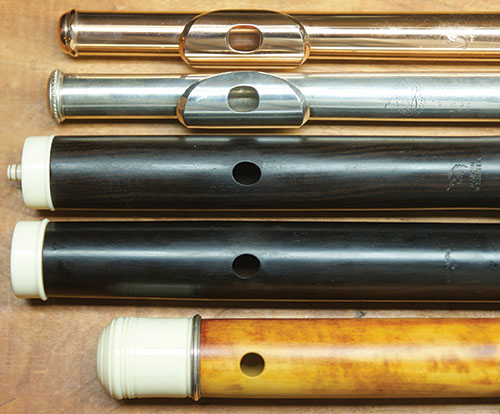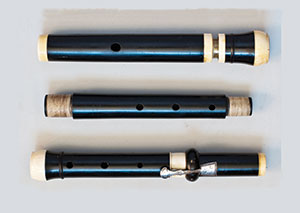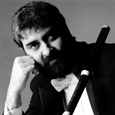Having a successful first experience on a Baroque flute will influence how likely a player is to continue with the instrument. While the help of an expert is always best, it often is not possible. Here are some tips that will help students get started with the Baroque flute and help more advanced players who are experiencing problems with the instrument.
Embouchure Hole
There are some things to think about before playing. It is important to understand that many things that work very well on modern flute do not work well on the Baroque flute. It should be thought of as a completely new instrument, but one that a modern flutist has a head start with. The goal should not be to make it behave like a modern flute.
Before playing a note, take a look at the embouchure hole of the flute. Compare it to a modern flute, and it should be immediately apparent that the Baroque flute has a much smaller embouchure hole, and it is shaped differently. Earlier Baroque flutes have a very small and round embouchure hole, while later ones often have a more oval-shaped hole. When playing modern flutes with a large embou-chure hole, flutists cover quite a bit of the embouchure hole with the lower lip. This is is not the case with the smaller hole on the Baroque flute. The smaller the hole, the more uncovered it needs to be. When I pick up the flute, I try to feel the very edge of the hole touching my lip. If you cover the hole too much, it lowers the pitch of the flute and makes the sound weaker. The Baroque flute is not a loud instrument, but you want to get out of it what it is built to give.

Embouchure holes on Baroque and modern flutes
Intonation
Another important step is to get a tuner and set it for the proper pitch of the flute. In most cases that will be A=415, or a half step below modern pitch. Start with a lower octave G, and try to play a medium volume G, checking it with the tuner. The first time you try the instrument you are likely to be either too sharp or too flat. If you are too flat, you are either covering too much of the hole or are blowing downwards too much. If you are sharp you are blowing too much across the hole and maybe too hard. Finding a good G is important before you try other notes.
When you feel good about G try the second octave G and make sure it is in tune with the lower G and has a nice, clean sound. Beginning students often come to me and complain that their instrument is way too sharp or way too flat. If you have a decent Baroque flute that is very unlikely. I can virtually always demonstrate that the flute can be well in tune. It is the approach to the embouchure or the amount of air that is causing the problem.
Before going any further, it is important to work out how to play at the proper pitch level. The instrument will not be able to produce a good sound or play in tune, if it is being played too sharp or flat. Your first impression might be “this flute must not really be at A=415.” If it is a flute from a good maker, it is you and not the flute that is at the wrong pitch.
Note Qualities
Different notes on the Baroque flute have different qualities from one another. This is one of the things that makes the instrument so expressive. Baroque composers understood this, and good flute music uses the tone of the note as well as the pitch to make the music more beautiful. G is a good clear note as are all the notes in a G major scale. The flute is in D major not C, and that is important to understand. I remember when I was first trying the Baroque flute and thought I would look for some easy sonatas to sightread. C and B-flat major are poor choices while D and G major are by far the simplest keys. If you close all six holes you can play a low D. Lift up the fingers one at a time and easily play a D major scale for two octaves. The third octave D is fingered as it is on a modern flute.
The D# Key
One important detail that new players need to fix securely into their brains is the use of the D# key which is not quite the same as on a modern flute. On a modern flute that key is part of holding the instrument. On a Baroque flute it is a little more complicated as it can sometimes help to hold the instrument. However, there are particular notes where players cannot use the key, and others where they must use the key. Two of these appear right away in the D major scale. E cannot be played on a Baroque flute using the key. This is extremely important, and it is harder than you might expect to learn. If you use the key, it makes E too sharp and the note too bright. The next note F# must have the key pressed as it is rather flat and needs the key to help bring up the pitch. You will see right away that even with the key pressed, the F# is going to be flatter than you are used to. Just accept that for now.

Traverso with D# key
Temperament
The Baroque flute is not in equal temperament like a modern flute. In the Baroque period, different types of temperaments and tunings were used, but the idea on the flute was to generally be playing pure intervals. So, if a flutist played an F#, it should sound pure to a D below it. This is not the case in equal temperament where the F# would be higher than pure. In modern playing people often play the F# even higher if it is a leading tone. None of that is relevant in Baroque music so accepting that F# is somewhat lower than you expect is fine. As you learn all the notes on the instrument, you will see that many notes require adjustment from the player – both to be in tune and to make the best sound. Remember that each note on the instrument has a distinct personality, especially those not in the D major scale.
Tricky Notes
Because the Baroque flute does not have a hole (and key) for each pitch as the Boehm flute does, it makes some more complicated fingerings necessary and requires various compromises regarding tuning. A good example of that is F natural. It is fingered 123 4-6 (no key). Remember that F# is 123 4-K. The pitch of those two notes is interrelated in that in order to get a workable F, which is naturally very sharp, you have to have a low F#. A good Baroque flute balances these fingerings so they both can be played well in tune with some effort. On cheap 19th-century flutes (which might look like a Baroque flute but are not) players often find that they have given up on the Fn completely and have an easy-to-play F#. Just for fun, try going back and forth between Fn and F#. You should find that without adjusting the difference is about a ¼ tone. Obviously, that will not do, and the secret is in how you play the notes. For the F# players should raise and use faster air, while for the Fn, they should use slower air, and blow more downward or rolling in.
A good exercise to get the hang of this is to play, slowly D – F# – D – Fn – D – F# and so on. Try to get the F to sound like an F, and the F# to sound like an F#. You may hear about alternate fingerings for notes like F#. For now, learn to use the correct basic fingerings rather than alternate ones. They might seem easier, but they are not producing the proper tone and relationship to adjacent notes.
The sound of the Fn is going to be softer than the F# and have a completely different quality. This is a good thing because each note should be beautiful in its own way. When players first encounter these covered-sounding, softer notes, they often try to blow harder. That does not work. I often think of trying to make a slightly bigger and definitely slower airstream to help find the resonance of those notes. At first this will feel like a big challenge, but as you gain in flexibility, you will find it easier and easier.
This brings up one of the most important things about playing the Baroque flute well. It is up the player to create the correct pitch and a beautiful sound. It is not possible to just use the right fingering and expect that the flute will be perfectly in tune. This is part of the instrument, and we know from historical documents that they took tuning extremely seriously in the Baroque. I remind students to imagine in their mind the note they want to hear and then play it. You cannot play the note, hear what is wrong, and then fix it. Learning to do this is of huge benefit to playing on any flute.
The G# in the lower octave (12-456) is another difficul note. Play the note G in tune and with a good clear sound. Now try the G#. This is probably the most different-sounding pair of notes on the flute. The G# has to be played gently, but if the embouchure and airspeed are adjusted well, it can be heard well and have a very beautiful quality. Play G – G# – G – G# and try to learn what you have to do to go back and forth between these notes. Next, play E – G# – E – B – E. You should find that somewhat easier than getting the half step to sound good. In proper tuning, sharps are low, and flats are high (relative to equal temperament.) This is fundamentally important to remember, so in the case of G# make an effort to keep it low enough. It is easier in the second octave.
.jpg)
Fingers and Balance
Another thing that is often a surprise to modern flutists is that on a Baroque flute, players have to keep their fingers further from the holes. Even on an open-hole modern flute, there is the key between the finger and hole. On a Baroque flute this is not the case as the finger directly closes the hole. If the fingers are too close, it affects the sound and tuning of other notes. It is good to be in the habit of controlling the finger technique just as much as on a modern flute, but maybe use a half inch distance as a guide. Consistent finger position is important on both instruments.
Many players are surprised at first that the instrument seems so big and at how much they have to stretch their fingers. On a modern flute the fingers are very close together and are closing the holes only with the help of keys positioned in other places along the instrument. After the initial surprise, most people acclimate to the larger size quickly. I do not think I have ever had a student who really could not reach the holes without injuring themselves.
On the right hand the fingers can be fairly flat, always moving from the knuckle. Do not try to play on the fingertips. The left hand is more complicated since the flute rests on the first finger joint. You still should not play on the finger tips, and the motion is from the knuckle. It is possible to play without the left thumb having much of a role at all. There is no thumb key (until we get to later keyed flutes), and it is good to check whether you can safely remove the thumb without feeling like the flute is going to fall.
Many people find the right-hand stretch to be the most difficult. I recommend trying to keep the fingers directly over the holes as much as possible as it is much simpler to drop a finger directly on the hole, than to have to move it sideways and put it down. You may find, especially at first, that it is useful to let the spacing of the fingers relax a bit when not being used, but try to keep the first finger over its hole so that the relative position is maintained.

Copy of a four-part flute after Naust by Boaz Berney
What to Practice
The temptation is to get out favorite Baroque pieces and try them right away, but it is better to leave Bach in the drawer at first. Focus instead on getting familiar with the details of playing each note. Play slowly for now and really try to get the notes in tune with a clear sound. Next, play some easy arpeggios and scales – G and D to start. You can venture into the third octave when you get confident with the first two. The fingerings are a bit more complicated up higher, and high E in particular often feels strange and backwards from a modern flute. The C in both octaves takes a while to get used to because it does not relate to the modern flute. While the fingerings may seem difficult at first, most people find that they learn them quite easily with practice. After all, there are only have six finger holes and one key to deal with. (You can find a good fingering chart here: www.Baroqueflute.
com/models/Grenser.pdf
One exercise I recommend to students is blowing slow, controlled, harmonics, both up and down. It produces some strange pitches along the way but will greatly help in building the embouchure in a way that makes the instrument easier to play. The goal is to be able to control when the note goes up or comes down without any articulation. This is also a great way to warm up quickly. Playing long tones and working on tone, dynamic, and tone control is extremely important.
Vibrato
An issue that comes up right away is vibrato. It is extremely important, especially at first, not to use any vibrato. It clouds the tuning and sound in a way that will not help you get the best from the instrument. There is virtually no evidence of breath vibrato for tone production being used in the Baroque period. There were other techniques they used to make individual notes expressive. It is too much to go into the details here, but I often tell students that when they find themselves wanting to add vibrato on a note, they should instead make a shape on that individual note. Long notes virtually always should have a shape. Hint, pay attention to the harmony under the note.
Tonguing
Flutists in the 18th century had a different outlook than is usually used today. The preference was for smooth tonguing unless indicated otherwise by some notation (a dot), or by convention (skipping notes). Stepwise 16th notes would generally be smooth but tongued. TaKa and its variations were not a part of the normal tonguing practice until the 19th century, and other very smooth double tonguing syllables were often used. See Quantz for his lengthy discussion about di’dl. Many flutists who get used to these Baroque articulation practices find the techniques they gain to be very helpful in their modern playing.
Tuning Software
Tuning software is your friend in learning to play the Baroque flute – especially to get off on a good start. As mentioned earlier, making sure you are really playing the flute at the correct pitch is critically important. Tuning software will help with this. In most cases, the tuning software allows you to select a temperament or tuning other than equal – which is important. Trying to play in equal temperament is unnatural on Baroque flute and will make your work more difficult. If your software has it, select 6th Coma Meantone (#).
The software I recommend if you have an Apple device is RTTAtuner, which is almost free. It keeps track of the tuning of whatever you play so you can see your tuning in context rather than a note at a time. This is extremely valuable. Other popular apps include Cleartune and PitchLab. Tuning on the Baroque flute is about the relationship of one pitch to another, and these software programs will help you understand that idea. Be sure not to rely on the tuner, however, as it is important to build good tuning into your ear and technique.
Listening
Having a good model in your ear for the sound of the Baroque flute is very important – even before you play your first notes. There are many fine Baroque flutists to listen to and I would recommend the recordings (easily available on YouTube) from Bart Kuijken, Anna Besson, Alexis Kossenko, Jan de Winne, Marten Root, Chris Krueger, Sandy Miller, and Marc Hantai. I am leaving out many fine players, but these flutists are a good place to begin. To hear the sound of many different flutes, go to my sites www.soundcloud.com/mloberlin and www.originalflutes.com
Once you have gotten started, it is always a good idea to find an expert teacher. There are also quite a few workshops on Baroque flute that will help you.
Remember that you create the sound and pitch on the Baroque flute. With attention to the basic ideas from the beginning, you will be able to bring out the beauty and musical qualities of the instrument.






